The More Things Change…
Five years after Liz Lerman’s departure, Dance Exchange continues to forge new initiatives.
Who gets to dance? Where is the dance happening? What is the dancing about? Why does it matter? In the 40 years since then-fledgling dancemaker Liz Lerman founded Dance Exchange, these four simple but profound questions have become not just the multigenerational company’s mission, but its raison d’être. “The four questions,” Cassie Meador, Dance Exchange’s current executive artistic director, says, “are at the core of everything we do.” Today, five years after Lerman left the company to work independently, the legacy she created is being reinvented by a new cohort of artists under Meador’s direction.
Lerman started the group in 1976 by drawing together a loose collective of artists: “That word ‘exchange’ grew out of my sensibility that mixing it up would be better. I was interested in getting African dance into the studio, and other forms. The idea was that even in dance we should be in each other’s genres.”
What has remained a constant at Dance Exchange, even after Lerman’s departure in 2011, is the ongoing nature of change in the organization, as well as those four questions. The company is continually evolving, adding and subtracting new programs or communities that it serves. “Those changes are in response to the curiosity of the artists at the core of the organization, but also in response to what we’re hearing from outsiders, what the need might be,” says Meador. Dance Exchange remains driven by the ideas and processes its resident and associate artists develop. During Lerman’s leadership her projects included long-range explorations of topical works—the human genome; genocide and reconciliation; the physics and morality of the first atomic bomb; what is praiseworthy in our lives, to name a few. Today Meador and associate artistic director Matthew Cumbie are delving into their own choreographic interests and evolving new processes that remain true to Dance Exchange’s core ethos.
Organizing Artists for Change, a new initiative Meador launched, offers opportunities for dance artists to explore the Dance Exchange methodology through workshops, institutes, residencies and process-oriented collaborative works. Dance Exchange will also begin work on a new multiyear project helmed by Cumbie called Growing Our Own Gardens, a look at queer world-making through dance, spoken word and drag. Off-Site/Insight: Stories from the Great Smoky Mountains, directed by Meador, will bring together artists from Asheville, North Carolina, along with the National Park Service, to dance on and about some of the oldest mountains in the world.
These days Lerman calls herself an alum—the works she now makes and the teaching and consulting positions she takes are independent of the company she founded, but she returns for visits on occasion for special events, like the recent 40th-anniversary celebrations. Lerman began work this fall as institute professor at Arizona State University’s Herberger Institute for Design and the Arts, the largest public arts school in the U.S. She intends to use her teaching to bring together students across departments and break down what she calls “silos” of learning and practice, creating pathways for cross-disciplinary work. Lerman and others will also work on disseminating her popular Critical Response Process, a systematic approach to addressing the development of art works with a critical eye focused on the artist’s needs, not the viewer’s desires. Though developed from art making, the system now serves dialogue in many fields.
She also has a few choreographic projects in the works; fans can expect deeply researched, compelling topics to emerge. For Lerman, “the idea of exchange means you can spend time in other people’s worlds—scientists, historians, painters—and you can maintain and enhance your personal discipline by making sure other people can come in.”




